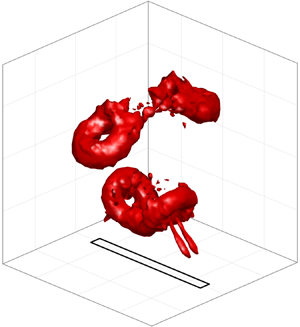Published online by Cambridge University Press: 02 October 2020

An experimental investigation using stereo particle image velocimetry (SPIV) was performed to study the vortex dynamics of an aspect ratio 13 rectangular orifice synthetic jet issuing into quiescent fluid. Data were obtained on the orifice centreline planes for four Reynolds numbers and five Strouhal numbers, ranging from 298 to 731 and 0.039 to 0.100, respectively. At one condition, SPIV data obtained on parallel planes distributed across the width of the jet were used to reconstruct the three-dimensional, three-component velocity field. The results reveal that the axis switching deformations of the non-circular vortex rings give rise to several types of secondary structures. Before the primary vortex ring completed its first axis switch, the anti-parallel sides of the ring collided, resulting in vorticity reconnection. Consequently, the elongated vortex ring bifurcated into two circular vortex rings which propagated off along independent paths. The development and structure of vortex ring bifurcation in addition to the bifurcation's effect on the jet shape, momentum and entrainment are presented. The bifurcation process captured in the synthetic jet experiment is similar in many ways to computational simulations of isolated vortex rings. Despite these similarities and the fact that vortex ring bifurcation was detected for all conditions tested, it is shown that the bifurcation process is sensitive to the unique conditions in synthetic jets, specifically the proximity of other vortex rings as indicated by the Strouhal number. Finally, the results at different jet conditions are discussed in relation to prior studies of synthetic jets.